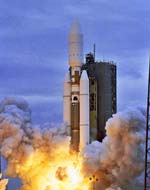
Image credit: Boeing
On the final mission for the program, a Boeing [NYSE:BA] Inertial Upper Stage (IUS) payload booster vehicle successfully deployed a U.S. Air Force Defense Support Program (DSP) satellite today.
The IUS-10 and its integrated payload, DSP-22, were launched aboard a Titan IV B rocket, which also flew with a Boeing-made fairing. Liftoff occurred at 1:50 p.m. EST from Space Launch Complex 40 at Cape Canaveral Air Force Station, Fla.
Upon separation from the rocket, IUS-10 fired its two stages to propel the spacecraft toward its geosynchronous orbit. Following roll maneuvers, the IUS successfully deployed the spacecraft.
?This last IUS mission added a critical asset to our nation?s military space program with the successful launch of DSP-22,? said Bill Benshoof, Boeing IUS program manager. ?The flight of IUS-10 concludes a 22-year journey for one of the most successful upper stages ever built and flown.?
The Boeing IUS program has supported national security, telecommunications and science missions with successful spacecraft deployments for the U.S. Department of Defense, the original Tracking and Data Relay Satellite constellation, and the Magellan, Galileo, Ulysses and Chandra missions for NASA.
Adding to the celebration of today?s successful last flight of the IUS, the Boeing IUS team received honors this week by the Air Force Association at the AFA?s Air Warfare Symposium in Orlando, Fla., for its significant contributions to the advancement of Air Force space activities in the last 50 years.
The Boeing IUS has been launched from the space shuttle and Titan IV rockets. There have been 24 IUS missions flown to date ? 15 launched from the shuttle and nine launched from the Titan IV.
A typical IUS mission launched from a Titan IV involves IUS separation from the rocket?s second stage booster approximately nine minutes into flight. The IUS takes over responsibility for the remainder of the powered portion of the flight.
For the next six hours and 45 minutes, the IUS autonomously performs all functions to place the spacecraft into its proper orbit.
The first IUS engine burn occurs a little over one hour into the IUS booster?s flight. The second solid rocket motor ignites about six-and-a-half hours into flight followed by a coast phase, and then, separation of the spacecraft.
IUS vehicle production was completed at Boeing in Kent, Wash. Spacecraft integration, checkout, ground operations and launch preparation activities were conducted at Cape Canaveral.
Boeing also produces the payload fairing for the Titan IV program. A 56-foot long fairing was used for the DSP-22 mission. Boeing-built fairings have flown on all 37 Titan IV launches to date and will fly aboard the remaining two Titan IV launches.
?This successful launch continues the 100 percent mission success record for the Titan IV payload fairing,? said Richard Peters, program manager and chief engineer, Boeing Titan fairing program.
The fairing for the DSP-22 mission was produced at Boeing in Huntington Beach, Calif., with the fairing?s thermal protection system applied at Boeing in Pueblo, Colo.
The Boeing IUS and Titan fairing programs are managed by Boeing Expendable Launch Systems in Huntington Beach.
The Defense Support Program is a satellite surveillance system providing the United States and its allies with ballistic missile early warning and other information related to missile launches, surveillance and the detonation of nuclear weapons.
A unit of The Boeing Company, Integrated Defense Systems is one of the world?s largest space and defense businesses. Headquartered in St. Louis, Boeing Integrated Defense Systems is a $27 billion business. It provides systems solutions to its global military, government and commercial customers. It is a leading provider of intelligence, surveillance and reconnaissance; the world?s largest military aircraft manufacturer; the world?s largest satellite manufacturer and a leading provider of space-based communications; the primary systems integrator for U.S. missile defense; NASA?s largest contractor; and a global leader in launch services.
Original Source: Boeing News Release

whats with all the question marks? hurts my eyes reading this